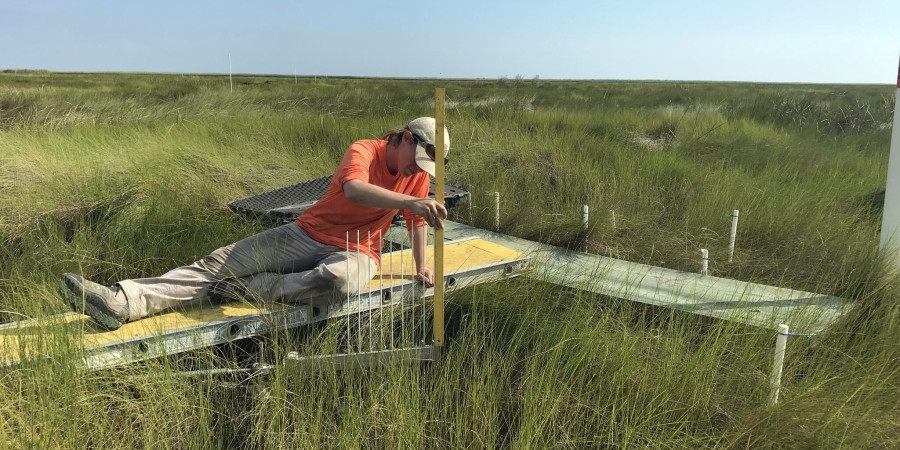By: Sharon Coogle, Koupal Communications
Originally published in the August 2018, Number 58 issue of WaterMarks
Jeremy Dunn, Coastal Estuary Services, LLC
Using a Surface Elevation Table device, a scientist measures the elevation of the marsh surface at a site in Louisiana’s wetlands to evaluate subsidence or land-building processes.
Monitoring is the Bedrock of Good Science
If you don’t know where you started, it’s hard to figure out how far you’ve come. Civic planners and coastal scientists need to know: How much land is Louisiana losing, and where? Are causes of land loss the same throughout the coast? How are other wetland conditions changing? Are marsh waters becoming more saline? Are marshes inundated more frequently? And perhaps most urgently, are the efforts to protect and restore the coastal environment effective?
Up until 2003 and the creation of the Coastwide Reference Monitoring System (CRMS), facts that would provide answers to these questions were hard to come by and often sketchy at best. Today, however, CRMS collects detailed information about wetland conditions at 391 sites across Louisiana’s coastal region. Put in place through the Coastal Wetlands Planning, Protection and Restoration Act (CWPPRA), the program uses sophisticated instruments and standard methodologies to gather a wide array of data. The types of data include:
- pedologic (pertaining to soils; i.e., surface elevation, vertical accretion, soil bulk density, percentage of organic material)
- spatial (i.e., percentages of water surface and land cover)
- hydrologic (i.e., water salinity, depth and temperature)
- vegetative (i.e., species’ cover and height)
Because CRMS’ sites are located both within and outside of CWPPRA project boundaries, scientists can compare data from restored and unrestored areas to determine the success of a specific project in producing environmental change. For example, if a project’s goal was to increase emergent vegetation and the data show no overall increase in emergent vegetation outside of the project but a spike of abundance within it, scientists would attribute the change to the project and look carefully at its techniques for application at other sites.
US Geological Survey
Peppering the coastal landscape, hundreds of CRMS’ sites provide data that describe conditions both inside and outside of CWPPRA project areas. Scientists use the data to determine the efficacy of restoration projects, the impacts of natural events, long-term ecological trends and the current condition of Louisiana’s coast.
CRMS’ sites are located in all types of ecosystems throughout the coast, providing multiple reference points to compare over time and across distances. For instance, researchers might select data to analyze salinity levels before and after a storm, or to compare freshwater marshes inside a project area with those outside of it, or to compare all freshwater marshes across the coast, or to study all restoration projects in a basin, or to look at all projects of one kind (e.g., hydrologic restoration) in the region. As well as determining project effectiveness, data identify locations in need of restoration, conditions to address, and restoration techniques most likely to be successful under a certain suite of circumstances. The scope of the CRMS network allows scientists and engineers to discern large, landscape-scale trends as well as determine conditions at specific sites.
Coastal Sustainability Studio, Louisiana State University
Coastwide Reference Monitoring System Stations
CRMS is the bedrock of coastal knowledge
Initially the purpose of CRMS was to collect the information needed to answer fundamental questions about CWPPRA projects:
• Is the restoration program reducing coastal wetland loss?
• Does the restoration program sustain a diversity of vegetation types within basins?
• Is the restoration program effective in reducing major stressors (e.g., flooding regime, salinity, elevation change)?
Because of its spatial and temporal reach, CRMS is valuable not just to CWPPRA specialists, but to restoration scientists and planners of state and parish projects, to researchers and academicians, to landowners and managers, to advocates and politicians.
Anyone curious about conditions in Louisiana’s coastal region can access CRMS’ data; it is free and publicly available at www.lacoast.gov/crms. Information is summarized in maps, charts, tables, graphs and report cards.
“The site gives us the elements necessary to educate people about what we’re doing to restore the coast,” says Brett McMann, an engineer who works for the Dutch private consulting firm Arcadis US. “It has numerous data collection tools that quickly and easily show site locations, landscape characteristics, hydrologic data and a host of other information that help us model coastal processes. We use the results to educate politicians and other decision-makers about conditions along our coast. The information that CRMS collects is the bedrock of knowledge for reengineering Louisiana’s coast to survive in the future.”
Become a Coastal Advocate!
Click here to subscribe to our blog and coastal updates.
Connect with Us! @LouisianaCPRA



